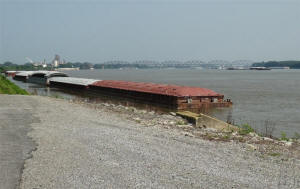Southern Illinois town pins hopes on river port development
 Send a link to a friend
Send a link to a friend
[September 23, 2021]
By PETER HANCOCK
Capitol News Illinois
phancock@capitolnewsillinois.com
 CAIRO – Anyone who has driven America’s
Interstate highway system is familiar with those standard blue signs
near major exits indicating the services available ahead – fuel, food
and lodging. CAIRO – Anyone who has driven America’s
Interstate highway system is familiar with those standard blue signs
near major exits indicating the services available ahead – fuel, food
and lodging.
Driving south on Interstate 57 in Illinois, approaching the city of
Cairo at the state’s southernmost tip, most of the images on those blue
signs have been erased. Only the “lodging” sign carries the logo of a
single economy-class motel chain.
Get off on Exit 1, just before the highway crosses the river into
Missouri, and it’s just a short drive into town. A railroad overpass
emblazoned with the name “Cairo” lets the driver know they’ve arrived.
Just beyond, it becomes apparent why those highway signs are mostly
blank.
The main street leading into town is dotted with one empty building
after another – buildings that used to be gas stations, convenience
stores, local eateries, even a grocery store. There is no place left in
town to buy gasoline or groceries. A single barbeque restaurant – said
by locals to be excellent – is the only place for dining.

This city at the confluence of two of the mightiest rivers in the United
States, the Ohio and the Mississippi, is the county seat of Alexander
County, which once boasted a population of more than 25,000. It is now
down to just 5,240, according to the 2020 U.S Census. That was a drop of
36.4 percent just in the past 10 years, the biggest population decline
of any county in the nation.
On the east side of town, just a few hundred feet from the Ohio River
levee, Larry Klein sits in his office at the Cairo Public Utility
Company, a nonprofit company that serves the community and, oddly, also
operates the town’s only hardware store.
Klein, 63, has lived in Cairo all his life and has watched its decline
firsthand. But he’s not despondent about it. In fact, he remains hopeful
of a turnaround.
“That's what this brings,” Klein said during an interview. “One of my
reverend friends, that's what he said. He said, ‘Larry, this – I'm
looking for the right word – the impact or effect this will have.’ He
said, ‘Larry, it brings us hope.’ And that's, that's the best word to
use.”
Klein was referring to a development project that has been on the
drawing board in Cairo for at least a decade, but which is getting a big
boost from the state with $40 million from the Rebuild Illinois capital
improvements program to develop an enormous river port along the
Mississippi River at Cairo. Klein serves as chairman of the Alexander
Cairo Port District, which is in charge of the project.
It’s estimated that about 80 percent of all the barge traffic in the
United States passes by or through the confluence of the two great
rivers. The river port at Cairo is envisioned as a facility where
barges, as well as larger “river vessels,” would unload cargo containers
that come upstream from New Orleans onto rail cars and semis for
distribution throughout North America.
Cairo is seen as a natural location for such a port because of its
proximity to the two major rivers – so natural, in fact, that many have
wondered why it hasn’t been done already.

State Sen. Dale Fowler, R-Harrisburg, a longtime advocate for the river
project, said he hears that question often.
“People say, ‘Well, senator, if this is such a great idea, why hadn't
somebody already done it,” he said during an interview in his district
office. “Well, why haven't we done a lot of things? I think this is
showing, with the increase of traffic, trucks, with the demand for river
transportation opportunities … container transportation alone is
expected to triple by the year 2030.”
Population declines
Alexander County is not alone among its southern Illinois neighbors in
seeing dramatic population declines in recent years. In fact, all five
counties that border the Ohio River saw significant declines. Pulaski,
Pope and Hardin counties all saw declines of more than 15 percent, while
Massac County lost about 8.2 percent of its population.
Throughout America, the 2020 census revealed a sizeable shift from rural
counties to more urban and suburban areas. But the dramatic drop in
Alexander County – and Cairo in particular, which is now down to just
more than 1,700 people – is unique.
The area where Cairo now sits was first settled by French explorers.
Lewis and Clark stopped there on their expedition to map the area of the
Louisiana Purchase. And during the Civil War, it was the home of Fort
Defiance, where Union soldiers led by Gen. Ulysses S. Grant defended the
rivers from Confederate forces.
For many years after the war, Cairo was an important transportation hub
for truck and rail traffic, as well as river traffic. Census data show
its population peaked in 1920 at more than 15,000, but it has been in
steady decline since then.
Some attribute that decline to racial tensions that have plagued the
community for more than a century. In 1909, it was the site of a brutal
lynching of a Black man named Will “Froggie” James, who’d been charged
with the rape and murder of a 22-year-old white woman. Tensions
continued into the 1960s and 1970s when Blacks in the community staged a
yearslong boycott of white businesses that refused to hire Black
workers.

For decades, all of Cairo’s public facilities were racially segregated,
including its public housing complexes. That eventually ended as white
families left the city and Black people made up a larger share of the
overall population. The latest census showed Cairo is now 70 percent
Black.
Those housing units, however, were closed and demolished in 2019 due to
deplorable conditions, prompting the exodus of some 400 households who
were given vouchers to move into any other public housing facility in
the country.
Klein, however, said he thinks there are more complex reasons for the
decline. Among other things, he points to the completion of I-57, which
diverted highway traffic away from the city, and the stronger economic
growth in nearby cities like Cape Girardeau, Missouri, that has pulled
many people away for better jobs.
[to top of second column]
|

Barges like these on the Ohio River near Cairo could
soon become a major source of economic growth for the region, which
suffered substantial population loss over the last 10 years.
(Capitol News Illinois photo by Peter Hancock)

“I mean, there was no opportunity here,” he said. “I
was fortunate enough – I don't know if it's a blessing or a curse –
to be able to find employment here and stay. Of course, I had five
brothers. All of them had migrated out of here for work.”
State Rep. Patrick Windhorst, a Republican from
Metropolis, in Massac County, which is farther upstream on the Ohio,
said he has seen the same thing happen throughout southern Illinois.
“We'll see our students, many of them, leave the state to go to
college and they won't come back, which is not unusual to rural
areas,” he said. “A lot of young people are attracted to Nashville
because it's a really booming area right now and it's only about two
hours away from Metropolis.”
But Windhorst said he also worries that the region is losing
population even among people who stay in the area but choose to move
across a state line.
“There are people who are my age and a little younger – I’m in my
mid-40s, we're talking about people maybe from 30 to 45 – who even
work in Metropolis or work in Illinois, but just move right across
the river to Paducah (Kentucky),” he said. “A common complaint is
property taxes. A common complaint is there's more things to do
there. They view it as having more opportunity. There is a component
that people point to, basic overall taxation. They feel like they're
paying less in taxes, they're getting more for their salary if they
just move across a river.”
Pinning hopes on the river
The site where the river port is planned is about five and a half
miles upstream from the confluence along the Mississippi. Driving
along the levee that protects Cairo from the river, Klein points to
the area where most of the port development would be built. It was
once heavily developed, before truck traffic was diverted from the
city, but is now mostly just grassland.

The land is owned by the utility company, which pays someone to cut
hay on the land. The plan is that when the port is operational, the
revenue would be split between Alexander County, the city of Cairo
and the utility. Klein says the utility would use its share to
reduce customer costs.
The hope is that the project will spur hundreds of construction
jobs, and then hundreds more permanent jobs for workers at the port
– workers who, it is hoped, would buy homes in the area and provide
an economic base for the redevelopment of grocery stores, drug
stores, gas stations and other basic amenities lacking in the town.
The potential for that kind of economic impact has helped state
lawmakers from the area gather support, first from former Republican
Gov. Bruce Rauner, and now from Democratic Gov. JB Pritzker, as well
as lawmakers from both parties and all parts of the state.
“I've had full support of both sides of the aisle,” Sen. Fowler
said. “It's been phenomenal. You know, when I talk about this, and
you have publications such as Waterways Journal that writes several
articles … they see the opportunity.”
“I believe it's going to be an economic driver for the entire
region,” Rep. Windhorst said. “And not only for southernmost
Illinois, but also western Kentucky and southeast Missouri. It's
going to be, I believe, a big economic driver, even after its
construction when it's in full operation.”
The port district recently signed a project labor agreement,
ensuring that an estimated 500 construction jobs will be filled by
union labor, a key element in securing state funding from the
Rebuild Illinois program.
“Cairo’s river port will stand as a shining example of Illinois’
leadership,” Pritzker said at a ceremony marking the signing of that
agreement. “Good jobs, multigenerational investments in economic
growth and community revitalization – this port will be a beacon, a
beacon for progress in southern Illinois and for our entire state of
Illinois.”

Still, the project is not a done deal. Klein noted that more than 20
state and federal permits must be obtained, including environmental
permits as well as an OK from the U.S. Army Corps of Engineers,
which has jurisdiction over the rivers.
“They are willing to bend over backwards,” Klein said of the Corps
of Engineers. “In our conversations we've had with them, they've
never told us no.”
Among the environmental concerns, he said, is that before the river
levees were built early in the 20th century, much of the land where
the project is planned was river bottom that was prone to flooding.
And although it once was developed, it’s now mostly vacant and the
drainage systems haven’t been maintained for 50 years or more.
“But there's been different improvements, let's say, made on the
river side to control the channel, the flow of the river,” Klein
said. “That's been done in the last, say, 20 years to where it's
actually shifted the main channel more towards Missouri, which
allows more room on the Illinois side, and you don't get the
sediment. Where we're wanting to place our docks, it doesn't have to
be dredged. It maintains deep water year-round, ice-free water.”
Assuming the permits all fall into place, Klein said construction
could begin in 2022 and the port could be operational in 2024.
Capitol News Illinois is a nonprofit, nonpartisan
news service covering state government and distributed to more than
400 newspapers statewide. It is funded primarily by the Illinois
Press Foundation and the Robert R. McCormick Foundation.
 |